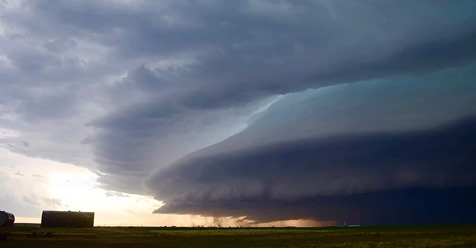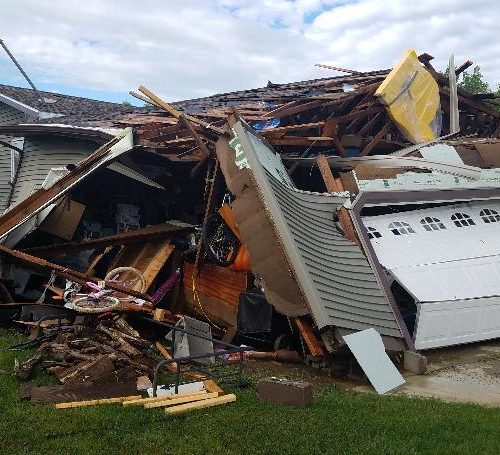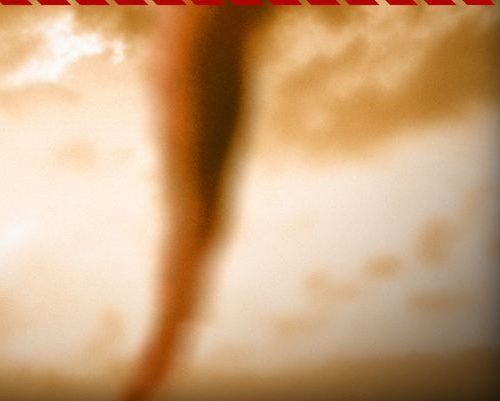Weather forecasters around the country strive to warn communities in advance of every tornado that touches down, each flash flood that is about to occur and each winter weather event.
One of the most reliable and costly tools at a meteorologist’s disposal for issuing watches and warnings is a network of 159 Doppler radars across the country that provide detailed views inside storms. Radar helps meteorologists determine precipitation type and intensity, how much rain or snow has fallen, as well as the wind direction and speed at which precipitation is moving within a storm.
Using these radars, forecasters can spot the existence of a tornado by detecting airborne debris lofted by the twister’s circulation. They can track the all-important rain-snow line in winter storms and even spot smoke plumes from severe wildfires. But as capable as the U.S. radar network is, gaps in coverage have drawn consistent complaints from meteorologists and lawmakers frustrated by unwarned-of severe weather.
Now, an overdue report to Congress from the National Oceanic and Atmospheric Administration (NOAA), which operates the National Weather Service, attempts to quantify the impacts of such gaps on warning performance. The results downplay the significance of the gaps, counter to the experience of some public- and private-sector meteorologists.
Several meteorologists said the congressionally mandated report inadequately addresses the true impacts of these gaps, describing its methodology as inadequate and incomplete and its conclusions as “disappointing” and even “offensive.”
The gaps, which the report identifies in some detail, occur in locations so far removed from radar sites that the beams emitted by the radar overshoot the weather they are intended to detect. The greater distance a location is from a radar site, the higher in the sky the radar scans for trouble.
The Charlotte metro area, home to about 2.6 million, is served by a Doppler radar 80 miles away in Greer, S.C., and the radar beam intersects clouds at about 5,000 feet or more above the city, missing some of the most important low-level weather features that can determine whether a storm will spawn a tornado. During the winter, some snow and ice events can take place largely below the height of the beam.
Other cities have far more coverage, including Washington, for which there is a Weather Service Doppler radar in Sterling, Va., as well as less powerful radars situated near the region’s three major airports and Joint Base Andrews. With radar beams reaching clouds at altitudes below 3,000 feet over the city, meteorologists have the ability to see the lower levels of storms, which is where tornadoes tend to form.
Radar gaps have been a contentious issue in the weather community for years, not only in Charlotte, but also in the Pacific Northwest, where spotting dangerous weather moving in from the Pacific is especially important.
Weather Service finally responds to Congress but says there’s no problem here
In a 2017 bill, Congress directed the Weather Service to examine how radar gaps affect warning accuracy and report to Congress within less than a year. Separately, Congress asked for a report on warning performance associated with radar coverage where the beam is 6,000 feet above ground level and higher.
Long past congressional deadlines, the radar gaps report was released in September to address both congressional requests, and it contains some surprising findings.
Instead of concluding that radar gaps make a difference in severe weather detection and warnings, as many meteorologists strongly suspect, the Weather Service told Congress that they make little to no meaningful differences in warning performance.
“Poor radar coverage is never the single contributing factor to an unwarned event,” the study found, instead blaming a cascade of factors including human errors for causing missed warnings.
For its analysis, the Weather Service study examined the 10-year warning performance at all NWS offices nationwide for tornado and flash flood events. In total, the report looked at more than 12,000 tornado events and more than 30,000 flash floods from 2008 to 2016, then compared events that took place within areas of dense radar coverage with those that did not.
The radar gap study found no “significant negative impact” to warning performance that could be “tied directly to radar coverage where the beam is higher than 6,000 feet above ground level.”
“That evidence does not mean radar is unimportant, rather it suggests that there is significant, usable radar data above 6,000 feet and other information employed by forecasters to issue warnings,” the study states.
The reason, the report says, “is that humans issue the warnings, not the radar.”
There’s enough radar data that can be gleaned above that altitude and other weather information, from surface reports to satellite imagery, that makes up for radar gaps, the weather agency told Congress.
“The data above 6,000 feet … that still provides tons of important information for forecasters like me who still use the data for warning decision processes,” said Paul Schlatter, science and operations officer at the Weather Service’s Boulder, Colo., office and the lead author of the radar gaps report summary.
However, the study did find some reduction in warning accuracy for weaker tornadoes, between EF-0 and EF-2 intensity, as well as flash flood warning performance, for areas that are farther from a radar site.
For stronger tornadoes, of EF-3 intensity or above, the study found the Weather Service rarely misses these warnings, and such strong tornadoes cause the majority of tornado fatalities. According to Schlatter, the agency issues warnings for 98 percent of those events.
Gaps report may have holes of its own
According to Rich Thompson, a meteorologist at NOAA’s Storm Prediction Center in Norman, Okla., research he’s involved in shows that tornado warning performance “generally drops off once you go beyond about 50 [nautical miles] from the radar (or above about 4,000 ft).” This decline is especially the case for weak and short-lived tornadoes, said Thompson, who was not involved in the radar gaps report.
“It would certainly be easier to detect possible tornadoes more consistently if we had radar coverage that allowed us to see the low levels everywhere,” he said.
Matthew Kumjian, a meteorology professor at Penn State University, said the methods used in the study aren’t particularly revealing because they did not assess weather forecast office performance in areas that have large data gaps versus the offices that are well-covered. He said the tone of the report’s summary struck him as aggressive and “suggests an underlying agenda.”
Several meteorologists in the private weather sector were also critical of the report, questioning its methods and conclusions.
Brad Panovich, chief meteorologist at NBC Charlotte, called the study “full of holes” and said it “misses a lot of the important issues of the effects of the radar gap.”
He said the Charlotte area does not typically get strong tornadoes from supercell thunderstorms more common in the Midwest and Plains. Instead, most of its tornadoes are weaker and shallower, making the distance from a radar site more significant.
“I think it misses the point of better and higher resolution data over such a populated area can save lives and mitigate dangers for people. It seemed kinda offensive to me, trying to minimize EF-0 to EF-2 tornadoes as not significant. I can find plenty of people including myself that have been impacted by such events and they are not insignificant to us or cheap to recover from,” Panovich said in an email.
Jonathan Porter, a vice president and general manager at the private forecasting firm AccuWeather, said he was “disappointed” by its conclusions.
“This report seems to gloss-over and over-simplify the challenging situation forecasters face each time severe weather approaches a known and well-documented radar gap to the detriment of public safety,” Porter said in an email.
Porter said AccuWeather provided its own report to congressional committee staffers in 2017 on the top 20 radar gaps nationwide, including southern Iowa and Charlotte.
Similarly, Mike Eilts, senior vice president at DTN, which owns the popular RadarScope app and provides forecasts to the agriculture sector, among other customers, said radar data is used for applications beyond warnings that can be affected by data gaps.
“In the agriculture industry, utilizing radar data to estimate precipitation over wide areas is invaluable for crop management,” Eilts said in a statement. “Poor radar coverage also has big impacts during winter weather events since most are low altitude phenomena.”
As was done in Charlotte, the Weather Service is now taking steps to lower the beam heights at 18 other radar sites to improve low-level coverage, said Weather Service spokeswoman Maureen O’Leary in an email.
“Increasing the area of low-level radar coverage may provide additional data about the atmosphere and improve some of the radar’s features.”
Congress may take action to fill radar gaps, but nothing concrete has been proposed. “My office was approached on this issue several months ago and we will continue to consider possible solutions,” Rep. Ted Budd (R-N.C.) said in a statement. Budd represents a district situated between Charlotte and Winston-Salem.
Jason Samenow contributed to this report.
by Andrew Freedman (2020, Nov 21) The Washington Post





